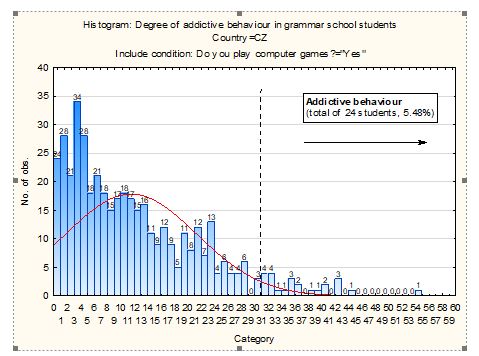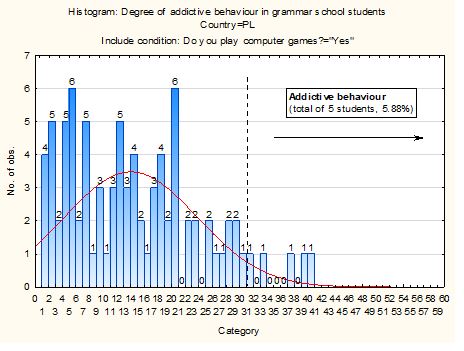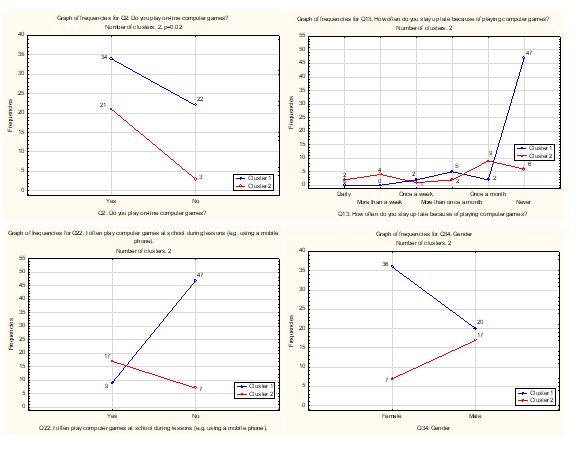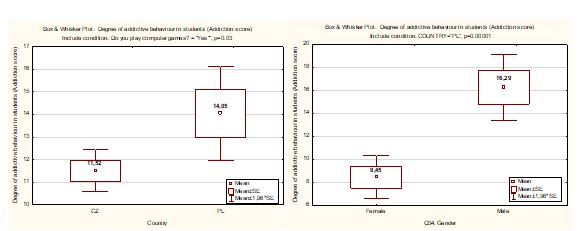Abstract
The paper describes the results of an international comparative research on the degree of computer game addiction among 18-year-old Czech grammar school students and Polish lycée students. For the purposes of the research a quantitative research strategy was used. The author developed a questionnaire to identify the degree of addictive behaviour in students in relation to computer games. The research sample comprised 525 Czech and 122 Polish students from 13 randomly selected grammar schools/lycées. The research was carried out in 2016 in the Czech Republic and followed by a comparative study in Poland in 2017. The aim of the subsequent statistical analysis was to identify groups of 18-year-old students by their addictive behaviour and perform an international comparison. The following methods were used: globalized cluster analysis, U-test, ANOVA analysis of variance. For the purposes of nominal data analysis the chi-squared test of independence was used. The degree of addictive behaviour was expressed as addiction score (0-60). A comparison of the degree of addiction revealed statistically significant differences between students from the two countries (score of 11.52 in CZ and 14.05 in PL). Polish students, unlike Czech students, were classified into two groups by addictive behaviour. The first group (approximately 30%) showed a higher degree of addictive behaviour, played PC games for a longer time per day, preferred online games, comprised mostly boys, played more often in classes and stayed up late more often. The group of Czech students was classified into three groups with different characteristics.
Keywords: Grammar school studentscomputer game addictiontypologyglobalized cluster analysis
Introduction
A large proportion of especially young people cannot imagine their life without information and communication technologies (Van Dijk, 2005; Zounek et al., 2016). Information and communication technologies also frequently represent a source of entertainment. From an early age, children play on the computer, tablet or mobile phone (Entertainment Software Association, 2015), and this innocent play (parents often believe this is a development supporting activity) may gradually change into a form of addiction.
According to the APA (2013), clinical computer game addition means that an individual meets five or more of the following symptoms in the course of a single year:
Pre-occupation (thinking about previous or next playing computer games becomes a dominant activity in life).
Withdrawal symptoms when gaming is inaccessible (typical symptoms include irritation, anxiety, stress or sadness, but there are no physical addiction symptoms).
Tolerance; an individual requires an increased amount of time for playing.
Repeated unsuccessful effort to control or stop playing computer games.
Loss of previous interests and hobbies, free time is devoted to computer games.
Continued playing computer games despite knowing the related psychosocial problems.
Deceiving the surroundings (family, friends) about the extent of playing computer games.
Playing computer games is a means of escaping from problems or relieving negative moods (feelings of helplessness, guilt, anxiety or depression).
Risk or loss of close relationships, job, education or career opportunities as a result of playing computer games.
The development of the addictive behaviour questionnaire was based on these typical risk symptoms
Problem Statement
However, existing research activities aimed at pathological adolescents’ addiction to gaming (including on-line games) and social networks (Kopecký, 2013) do not deal with the negative impact of these on-line activities on the course of the educational process. Teachers do not often notice these activities of their students in classes or think that they are unimportant. In the teaching process, teachers seldom use computer-based didactic games (Stoffová, 2016a, 2016b; Czakóová, 2016) which can motivate and increase learner engagement in their studies. Hence, the so called ‘addiction’ can be transformed into educational outcomes if properly planned and integrated into the curriculum.
Research Questions
The basic research question formulated in the framework of the present comparative research study asks about the degree of addictive behaviour in grammar school students in relation to computer games in Czech Republic and Poland. The next question focuses on whether there are typical groups of 18-year-old grammar school students by their attitude to computer games and by their degree of addictive behaviour. Does playing computer games differ between Czech and Polish students? Do grammar school students play didactic computer games? The author of the present study also examined whether addictive behaviour in terms of playing games was dependent on gender and whether these expected differences were identical in both countries.
Purpose of the Study
The objective of the research study was to determine the degree of addictive behaviour in relation to playing computer games in Czech and Polish 18-year-old grammar school students.
Another objective of the research was based on an analysis of responses of grammar school students, to hypothetically divide these students into characteristic groups according to the degree of their addictive behaviour in relation to playing computer games. On the basis of previous research studies (Chráska jr, 2016a, 2016b), the authors investigated whether Polish grammar school students had identical opinions about playing computer games with Czech students.
On the basis of theoretical knowledge, however, it was impossible to determine how many groups of students should be identified. Therefore, it was decided to determine the number of typical groups of students according to the Generalized Cluster Analysis, which can positively quantify the number of groups in the research sample.
Research Methods
Research instrument
For the purposes of the research the authors used a yet semi-standardized questionnaire (Chráska sr, 2016), which was based on a questionnaire used in 2015 (Basler, 2016; Chráska jr. & Basler, 2016). For the purposes of an IGA project aimed at the issue of student addiction to computer games in a wider context, in 2016 new items were added to the questionnaire. The purpose of the questions was to determine detailed characteristics of the types of students according to their addition to computer games Apart from these characteristics, the questionnaire focused on the degree of addictive behaviour in relation to playing computer games by means of 12 statements. The degree of agreement with each statement was indicated by the students on a six point scale with coded answers: totally agree (value 5), agree (4), rather agree (3), rather disagree (2) disagree (1) completely disagree (0). Regarding the extent of the paper, Table
Description of the research sample
The research study was carried out in 10 randomly selected grammar schools in the Czech Republic in the Olomouc Region, Pardubice Region, Moravian-Silesian Region and Zlín Region in May 2016 (Chráska jr., 2016a, 2016b; Chráska jr. & Basler, 2016). A comparative research study was carried out in Poland in three lycées in the Rzeszow region in spring 2018. The overall research sample consisted of 647 students in grade three of four-year grammar schools (or an equivalent grade of multi-year grammar schools in Czech Republic) and lycées in Poland. The structure of the respondents is specified in Table
Reliability of the addictive behaviour questionnaire
The reliability of the questionnaire was tested for questions relating to addictive behaviour. The reliability of the questionnaire was determined by means of Cronbach’s alpha. Its value was 0.95 (total), 0.90 (Czech), 0.89 (Polish), which means that the research was reliable. The reliability of the questionnaire was also determined separately for the group of male students (r=0.91) and the group of female students (r=0.97). It is evident that the reliability of the research was higher for the group of female students as it generally reached the required value of 0.80 (Chráska sr., 2016).
Findings
In compliance with the research questions, the results of the comparative research are provided in detail and arranged in 7 sub-chapters.
Identification of addictive behaviour in grammar school students in relation to playing computer games – Czech Republic
Based on the students’ responses to twelve questionnaire items (Q5, Q10, Q11, Q12, Q15, Q16, Q17, Q18, Q19, Q20, Q21 and Q13 – see Tab.

Identification of addictive behaviour in grammar school (lycées) students in relation to playing computer games – Poland
Similarly to Czech students, addictive behaviour among Polish lycée students was determined. The overall addictive behaviour score is shown in Figure
The total number of students who achieved more than 30 points was 5 – see Fig.

Identification of typical groups of students according to their attitude to computer games - Czech Republic
An analysis of typical groups of Czech students had been performed in a previous research study (Chráska jr., 2016a) using the Generalized Cluster Analysis. Therefore, this paper will only specify the main results. The results of the research study suggested three groups (clusters) of Czech 18-year-old grammar school students according to their attitudes to computer games. These groups also showed a completely different degree of computer game addition.
Cluster 1 includes students who often play PC games including on-line games, their parents often set limits for playing computer games, and as a result of playing they stay up late (but only once a month). They often play computer games at school in classes (e.g. using a mobile phone), and sometimes on Facebook. The group is slightly dominated by female students. The students play PC games for 81 minutes on average, in their free time they do sports. The students in this group show a lower addictive behaviour score (average score 23) and comprise about 25% of all students.
Cluster 2 includes students with the lowest addictive behaviour score (average score 15), they play PC games for only 26 minutes a day games on average, they do not play on-line games, in their free time they go out with friends. More often they play educative computer games; they started playing at about 9.5 years of age. This group is significantly dominated by female students and comprises about 39% of all students.
Cluster 3 includes students with the highest addictive behaviour score (average score 32), they play PC games for approximately 2.5 hours a day, mostly on-line, in their free time they again play computer games. As a result of playing games, the students also stay up late (typically once a week and once a month). When they do not play, they are more stressed than the students in groups 1 and 2. For them, PC games are the most powerful tool for relaxation, they often play PC games even if they have school assignments (e.g. preparation for a test), and frequently they cannot imagine their life without PC games. This group is significantly dominated by male students; they have played computer games since about 8 years of age; the group comprises about 36% of all students.
Identification of typical groups of students according to their attitude to computer games -Poland
Similarly, to the group of Czech grammar school students, Polish students were divided into typical groups using the Generalized Cluster Analysis. Unlike Czech students however, Polish grammar school students can be divided only into two typical groups by the degree of addictive behaviour and other characteristics. The results of the analysis are shown in Figure

The first group of Polish students (cluster 2) comprises students with a higher degree of addictive behaviour (average score 24.29), who play computer games on average for 200 minutes per day, play online games more often; this group consists predominantly of male students. The proportion of Polish students in this group is approximately 30%.
Similarly, the students in this group also mostly play computer games in classes and sometimes stay up late because of playing (but most of them just once a month).
The second group of Polish students (cluster 1) comprises students with a lower degree of addictive behaviour (average score 10.36), who play computer games on average for 101 minutes per day; this group consists predominantly of female students. The proportion of Polish students in this group is approximately 70%. Similarly, the students in this group mostly do not play computer games in classes and do not stay up late because of playing.
Unlike Czech students, the two groups do not differ in the beginning age of playing PC games (both groups start after 8 years of age). If they have free time, the students in both identified groups go out with friends.
Addictive behaviour in the context of playing games among Czech and Polish grammar school students
The authors also investigated whether there were any differences in students’ addictive behaviour in relation to playing games between the two countries. A comparison of average addiction score was performed by means of the t-test. The results are graphically shown in Figure

Addictive behaviour in relation to playing games in Polish grammar school students by gender
The authors also focused on whether addictive behaviour of Polish students in relation to playing games was dependent on gender. A comparison of average addiction score was performed by means of the t-test. The results are graphically shown in Figure
Playing computer games and didactic computer games among Czech and Polish grammar school students
A comparison of the frequency of playing computer games among grammar school students in both countries was performed by means of the chi-squared test of independence. The results are shown in Table
The authors also investigated whether the frequency of playing didactic computer games was identical between Polish and Czech grammar school students. The comparison was performed using the chi-squared test of independence; the results are presented in Table
The values in Table
Conclusion
A comparison of the degree of addiction revealed statistically significant differences between students from the two countries (score of 11.52 in CZ and 14.05 in PL). It needs to be stated however that Polish grammar school students (70%) played computer games significantly less frequently than Czech students (83%). Polish students, unlike Czech students, were classified into two groups by addictive behaviour. The first group (approximately 30%) showed a higher degree of addictive behaviour, played PC games for a longer time per day, preferred online games, comprised mostly boys, played more often in classes and stayed up late more often. The group of Czech students was classified into three groups with different characteristics.
At the same time, it should be noted that high-risk online activities of students affect their personality characteristics and family relationships.
High neuroticism is frequent in avid players who use games to avoid difficult life situations and to cope with (or realize by themselves) unsuccessful impulses (Blinka et al., 2015, 2016). Other research studies on this topic identified a correlation between the onset of addictive behaviour and other personality characteristics, for example higher extraversion and openness to experience cause more frequent use of social networks. Complicated relationships with parents, parental conflicts, difficult interpersonal relationships and an increased level of social anxiety are also factors that have an effect on the development and maintenance of Internet addiction (Bernardi & Pallanti, 2009; Cerniglia et all., 2016).
Acknowledgments
The paper was supported by the following project of Palacký University in Olomouc: IGA_PdF_2018_030 ‘An analysis of the use of educational computer games and online educational courses in secondary schools in relation to potential addictive behaviour in students in relation to gaming’. The author would like to thank Dr. Waldemar Lib from the University of Rzeszow for assistance in the implementation of the research in Polish grammar schools.
References
- APA. (2013). Diagnostic and Statistical Manual of Mental Disorders: DSM-5, (5th ed). Washington, D.C., American Psychiatric Publishing.
- Basler, J. (2016). Počítačové hry a způsob jejich využívání u žáků základních škol. Trendy ve vzdělávání, 9(1), 10-19.
- Bernardi, S. & S. Pallanti. (2009). Internet addiction: A descriptive clinical study focusing on comorbidities and dissociative symptoms. Comprehensive Psychiatry, 50(6), 510-516. Retrieved from: http://dx.doi.org/10.1016/j.comppsych.2008.11.011.
- Blinka, L., Ševčíková, A., Škařupová, K., Vondráčková, P. & Š. Licehammerová. (2015). Online závislosti. Praha: Grada.
- Blinka, L., Škařupová, K. & K. Mitterova. (2016). Dysfunctional impulsivity in online gaming addiction and engagement. Cyberpsychology: Journal of Psychosocial Research on Cyberspace, 10(3), article 5. Retrieved from: http://dx.doi.org/10.5817/CP2016-3-5
- Cerniglia, L., Zoratto, F., Cimino, S., Laviola, G., Ammaniti, M. & W. Adriani. (2016). IA in adolescence: Neurobiological, psychosocial and clinical issues. Retrieved from: http://dx.doi.org/10.1016/j.neubiorev.2016.12.024.
- Chráska, M. jr. & J. Basler. (2016). Research of Computer game addiction among the 18-year old students of general upper secondary schools in the Czech Republic. In: ICERI 2016 Proceedings. Seville, 9th International Conference of Education, Research and Innovation, pp. 69-78. Seville: ICERI.
- Chráska, M. jr. (2016a). Computer Games – Preferred Way of Using ICT by Grammar School Students. In The European Proceedings of Social & Behavioural Sciences EpSBS, XVI, London: Elsevier Ltd., pp. 606-616. ISSN 2357-1330. Retrieved from DOI 10.15405/epsbs.2016.11.63
- Chráska, M. jr. (2016b). Grammar School Students and Their Typology According to Dependence on Computer Games. In SGEM 2016 Conference Proceedings. Sofia: STEF92 Technology Ltd., 2016, pp. 795-802. ISBN 978-619-7105-70-4. ISSN 2367-5659. Retrieved from DOI 10.5593/SGEMSOCIAL2016/B11/S03.101
- Chráska, M. sr. (2016). Metody pedagogického výzkumu. 2. aktual. vyd. Praha: Grada.
- Czakóová, K. (2016). Creation small educational software in the micro-world of small languages. In: Teaching Mathematics and Computer Science, 14(1), 2016/1, 117. Debrecen: University of Debrecen.
- Entertainment Software Association. (2015). Essential facts about the computer and video game industry [online]. [cit. 2016-07-30]. Retrieved from: http://www.theesa.com/wp-content/uploads/2015/04/ ESA-Essential-Facts-2015.pdf
- Kopecký, K. (2013). Rizikové chování studentů Pedagogické fakulty Univerzity Palackého v prostředí internet. Olomouc: Univerzita Palackého v Olomouci.
- StatSoft, Inc. (2013). STATISTICA (data analysis software system), version 12. Available from: http://www.statsoft.com.
- Stoffová, V. (2016a). Počítačové hry a ich klasifikácia. Trendy ve vzdělávání, 9(1), 243-252.
- Stoffová, V. (2016b). The Importance of Didactic Computer Games in the Acquisition of New Knowledge. European Proceedings of Social and Behavioural Sciences EpSBS, 16, 676-685.
- Van Dijk, J. (2005). The Deepening Divide: Inequality in the Information Society. London: SAGE.
- Zounek, J., Juhaňák, L., Staudková, H. & J. Poláček. (2016). E-learning. Učení (se) s digitálními technologiemi. Praha: Wolters Kluwer ČR, a. s.
Copyright information

This work is licensed under a Creative Commons Attribution-NonCommercial-NoDerivatives 4.0 International License.
About this article
Publication Date
14 January 2019
Article Doi
eBook ISBN
978-1-80296-052-5
Publisher
Future Academy
Volume
53
Print ISBN (optional)
-
Edition Number
1st Edition
Pages
1-812
Subjects
Education, educational psychology, counselling psychology
Cite this article as:
Chráska, M. (2019). Typology Of Czech And Polish Grammar School Students By Computer Game Addiction. In Z. Bekirogullari, M. Y. Minas, & R. X. Thambusamy (Eds.), ICEEPSY 2018: Education and Educational Psychology, vol 53. European Proceedings of Social and Behavioural Sciences (pp. 783-793). Future Academy. https://doi.org/10.15405/epsbs.2019.01.77

